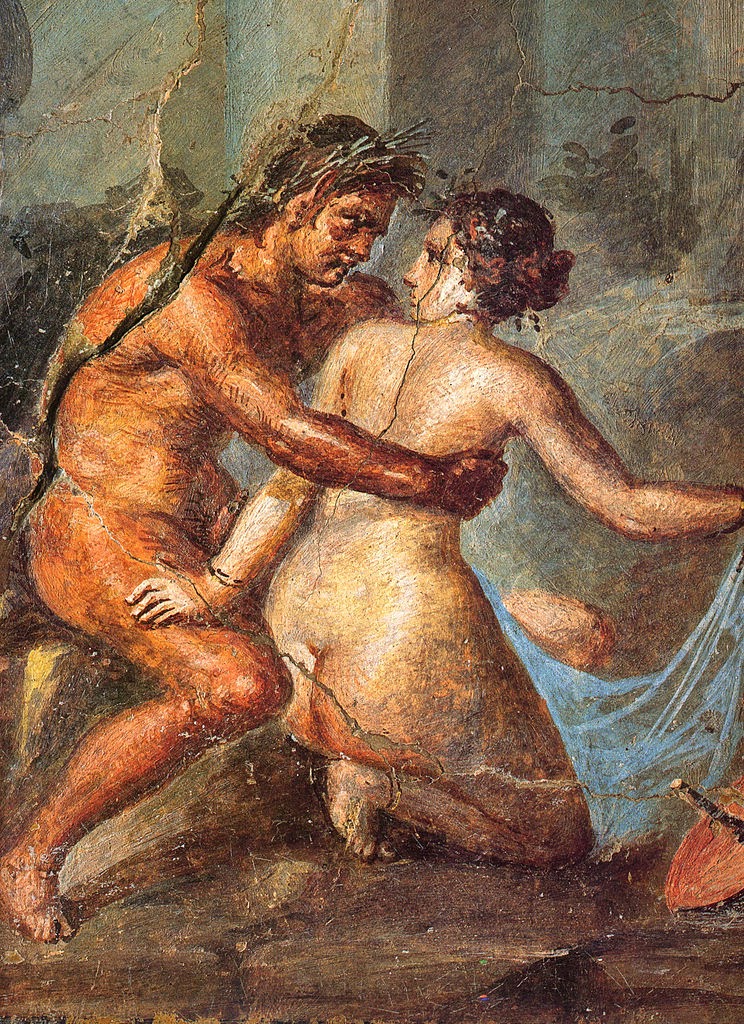 |
| Satyr and Maenad. Roman fresco from Casa degli Epigrammi in Pompeii. |
The Secret Cabinet- Gabinetto
Segreto
The term Secret Museum or Secret
Cabinet (Gabinetto Segreto) principally refers to the collection of
erotic or sexually explicit finds from Pompeii, held in separate galleries in
the Naples National Archaeological Museum Naples,
Italy, and the former Museo Borbonico.
 |
| Naples National Archaeological Museum |
The Cabinet of "Obscene Objects" was created in 1817 to
bring together about a hundred miscellaneous items which were only to be viewed
by important visitors of the male sex on obtaining the relevant authorization from
the Ministry.
 |
| Giuseppe_Fiorelli |
In the prurient climate of restoration in the 1850s it was closed
to viewing, but following the unification of Italy it was reopened and the
collection was published by Giuseppe Fiorelli in 1866.
After the turn of the century it was dispersed, but it is now
being reconstituted and enlarged with some two hundred other items. This
cabinet was again closed many years and finally reopened in year 2000 as a show-piece of museographical history.
Roman sexuality was a big
problem for the 19th-century archaeologists and
curators responsible
for excavating and preserving the remains of Pompeii and Herculaneum.
Romans and citizens of
Pompeii and nearby Herculaneum in particular, had a robust appreciation for the
erotic in art and everyday objects.
 |
| Fresco of Priapus, Casa dei Vettii, Pompeii. Depicted weighing his enormous erect penis against a bag of gold. Unlike the Greeks, Ancient Romans admired the large penis of Priapus, although they had a sense of humor about it |
The enormously
well-endowed god Priapus was a common good-luck symbol, seen in everything from
frescoes to penis-shaped wind chimes to perky oil lamps. (His huge member
supposedly had little to do with sex: It served to scare off thieves.) Stories
from mythology painted on walls were full of sexual encounters, secret trysts,
and naughty satyrs. In some ways, this erotica was widely accepted on a level
that even modern society would have trouble with, let alone Victorian Europe.
The ancient Roman and Greek cultures had a very different attitude
about sexuality than successive European cultures, more akin to that of the
Kama Sutra. This, of course, was unimaginable to latter day Europeans, who
rigidly compartmentalized body, mind and spirit, and to whom any sexuality was
sinful and morbid.
 |
| foto-vesuvio1 by Giovanni Lattanzi |
Some of the best artistic expressions of this can be found in the
recovered city of Pompeii.
Pompeii was frozen in time by the volcanic eruption
of Vesuvius in 79 A.D., and not unearthed until 1748.
Pompeii was a seaside
resort, devoted to the arts, relaxation, and the pursuit of pleasure.
 |
| Charles_III_of_Spain |
The looting of Pompeii began in the late 1700s
under the direction of Charles of Bourbon, better known as Charles III of
Spain, who was after fashionable antiquities for his private collections.
When Napoleon's brother rolled into town in 1806, the French
regime drew up the first organized plans to excavate the city in its entirety,
and this process continued when control of Naples reverted to the Bourbons
under Ferdinand I.
The excavators were horrified to
discover erotic frescoes, mosaics, statuary and phallic votive objects. The moveable
erotic artifacts were taken to Naples and kept in seclusion in the Royal
Museum.













